

III

Preparing for our farewell recital at the Smithsonian before we moved to Oberlin in 1971.
What is a collector? In my experience, he is someone who not only gathers material objects for acquisition’s sake, but also becomes involved with the place of origin, the time, the context of the objects. He studies the construction, the history of each piece, and has concern for the well-being of these objects of his desire. James Caldwell was a collector.
Considered by many to be the finest oboist of his generation, Jim was already a collector when I met him. He owned 3000 LPs, four vehicles including two vintage Jaguars, any number of Lorée oboes, and six modern gambas. His rationale for owning the gambas was that if one expected to encourage people to learn to play, one needed to be able to supply them with an instrument. It worked for me, then a young cellist just graduated from Eastman. We had both joined a new chamber orchestra in the fall of 1966. The Chamber Symphony of Philadelphia was a vision of Anshel Brusilov, then concertmaster of the Philadelphia Orchestra and an aspiring conductor. He brought together a marvelous mixture of thirty-six young people, newly retired members of the Philadelphia Orchestra, and mid-career players who were eager to play in a chamber group. It was a dream job with a great contract and a promise from RCA to make five LPs. Jim was first oboe and I, assistant principal cello, but he spotted me immediately as a good prospect for playing viol. As soon as I heard his exquisite first notes of Rossini’s Overture to La Scala di Seta, a piece with a famous oboe solo, I was looking for more from him than just to learn to play the viol. He asked me over to “see his gambas” in September, and in February we were married.
This recording of Ravel’s Le Tombeau de Couperin, made in 1967 for RCA by the Chamber Symphony of Philadelphia, affirmed Jim’s reputation as the leading oboist of his generation. It remains a cult classic recording among oboists. Because of time constraints, we made the recording in one take until the last movement, when Jim purposefully made a mistake in order to stop to rest for a moment. Courtesy of Boston Records.
/ 03:23
This recording of Ravel’s Le Tombeau de Couperin, made in 1967 for RCA by the Chamber Symphony of Philadelphia, affirmed Jim’s reputation as the leading oboist of his generation. It remains a cult classic recording among oboists. Because of time constraints, we made the recording in one take until the last movement, when Jim purposefully made a mistake in order to stop to rest for a moment. Courtesy of Boston Records.
/Our gamba activity for the first two years was limited to social consort playing. We gathered about once a week with friends, and often worked on the extensive literature for two bass viols. In our free summers we went to several workshops, and in 1967 attended a week-long masterclass taught by the Swiss virtuoso, August Wenzinger, whom Jim had long admired. That week began a long collaboration with him and started me on my journey into the vast solo repertoire for viol. Jim and I still played a lot of duets, but he was now just as happy to be leading from the basso continuo line. As we met more players we saw more varied instruments including Wenzinger’s Stainer viol made in 1673. Jim’s appetite for an antique instrument was whetted and the Hasert came into our lives. With the miraculous acquisition and then the restoration of the Tielke, we were completely hooked. Soon we were learning about the French literature, which requires seven-string viols, and the search was on for two of them. Then, of course, we needed two nice old English viols for consorts. And what about an old treble?
Jim and I were so proud to be the first in America to perform and record the newly discovered music of Le Sieur de Sainte-Colombe, now a staple of the viol repertoire. The manuscript was found in a collection in France, given to the Bibliothèque Nationale in Paris in the mid-1960s, and was to be held back from public use until it was published in an academic edition. A Parisian friend of ours, Jean-Pierre Batt, “snuck” in, copied out some promising duets, and gave them to us. We used his copy until we were able to get a copy of the microfilm of the manuscript. We eagerly played all the duets and made a number of decisions interpreting the difficulties of the manuscript, based on our musical reponse to the complete work. We discovered that our interpretation differed substantially from the academic version that is published and wished that more people had access to the manuscript so they could make their own decisions. This duet is “Le Crantif and Allemande ” and we are playing the Ouvrard, now in the collection of Mary Anne Ballard, and the Lambert. Courtesy of Vox.
/ 04:04
Jim and I were so proud to be the first in America to perform and record the newly discovered music of Le Sieur de Sainte-Colombe, now a staple of the viol repertoire. The manuscript was found in a collection in France, given to the Bibliothèque Nationale in Paris in the mid-1960s, and was to be held back from public use until it was published in an academic edition. A Parisian friend of ours, Jean-Pierre Batt, “snuck” in, copied out some promising duets, and gave them to us. We used his copy until we were able to get a copy of the microfilm of the manuscript. We eagerly played all the duets and made a number of decisions interpreting the difficulties of the manuscript, based on our musical reponse to the complete work. We discovered that our interpretation differed substantially from the academic version that is published and wished that more people had access to the manuscript so they could make their own decisions. This duet is “Le Crantif and Allemande ” and we are playing the Ouvrard, now in the collection of Mary Anne Ballard, and the Lambert. Courtesy of Vox.
/Jim determined that the best way to find instruments was to let as many people as possible know that we were interested and willing to pay top dollar for something we wanted. We soon had a number of dealers from all over the United States and Europe sending us pictures and information. Another essential part of the gathering process was gaining knowledge. Jim devoured books on stringed instruments. There were very few pictures of antique viols published at that time so he studied violins and cellos. We subscribed to auction catalogues from Sotheby’s and Christie’s in order to study the pictures. He talked at length to instrument makers, museum people, dealers and restorers. Once we owned an instrument he would spend hours examining it.
Another significant part of the history of this collection was Jim’s interest in “tweaking” each instrument to sound better. He became a fanatic about setting up the instruments. In the 1960s few string repair people had specialized knowledge of viols and most treated them as second-rate cellos. They had no historical knowledge (see the Tielke story) and little practical knowledge. Jim had started playing viol in Puerto Rico, where the humidity is always near 100%. Playing on gut strings was impossible and he made himself strings by twisting the thread that oboists use to wrap their reeds to appropriate thicknesses for the different strings, or by using nylon thread that he sanded at the playing area so it could hold rosin. I was a typical string player who runs to her special string repairperson to do the smallest adjustment, so it took me quite a while to accept Jim’s hands-on approach. I finally realized that as a professional oboist Jim created his instrument on a daily basis by reedmaking, and that he felt more personally capable as well as responsible for the setup of any instrument. I began to value the new ideas he was bringing to other players and makers.
One adjustment that he was very keen on in the late 1960s was having the bridge set lower on the belly than the makers at that time were doing when they delivered their new instruments. Most makers were assuming a pitch of a′=440Hz, but we were playing at the more historical pitch of a′=415Hz or a′ flat. We needed a longer string length to make the viols sound good at 415, so he just moved the bridge (and soundpost) to the lowest spot that one could play without hitting the edge of the bouts with the bow. During the first few years we spent much of our time convincing other players to try this with their viols and almost all sounded better immediately. Soon the makers started using the longer string lengths from the beginning. Most of Jim’s approach to these matters was pragmatic or technically based, not theoretical. For example, he had a formula for a good bridge curvature that was a simple visual trick, not a mathematical formula.
Jim spent several weeks with Paul Reichlin in Switzerland studying bridge-making and came home to fit several of our instruments with his newly designed bridges. All sounded noticeably better. We spent years in pursuit of decent strings. At one time we ordered them directly from a surgical gut manufacturer located next to the Chicago Stock Yards. They actually smelled of the real animal! By the time that firm went out of business because of the use of the surgical staple, there began to be an interest in historical string making and we tried all of those products.
By 1974 Jim had published a catalogue of the instruments we had collected in the Journal of the Viola da Gamba Society of America and more people became aware of what we had. We showed the collection to many players, museum curators and makers. A number of makers spent time studying and measuring the viols and this became one of the important reasons for continuing with the collection.
In the mid-1970s we started a series of recordings on the Cambridge, Vox and Gasparo labels that used the instruments. I recorded the J.S. Bach Sonatas for viol and harpsichord using three different viols and two harpsichords.
Rehearsing and performing the Bach sonatas with the late Doris Ornstein was one of the joys of my life. Jim actually became jealous of our success with them. I believe it was one of the reasons he started pursuing the baroque oboe, as he felt he was not needed as my continuo player. However, he and Doris had a wonderful bond of mutual respect and humor. This is the final movement of the third sonata in g minor. Courtesy of Gasparo Records GG-1001.
/ 03:42
Rehearsing and performing the Bach sonatas with the late Doris Ornstein was one of the joys of my life. Jim actually became jealous of our success with them. I believe it was one of the reasons he started pursuing the baroque oboe, as he felt he was not needed as my continuo player. However, he and Doris had a wonderful bond of mutual respect and humor. This is the final movement of the third sonata in g minor. Courtesy of Gasparo Records GG-1001.
/The opening Caprice from Marin Marais’s Suite for Three Viols in G Major from Livre IV was the first piece ever performed at the Baroque Performance Institute. It became our signature piece and we performed it at least three times at BPI as well as including it on our first BPI recording. August Wenzinger played a copy of his Stainer viol by Paul Reichlin, I played the Bertrand, and Jim played the Lambert. There is a video of a performance that I hope to release in the near future.
Recording in the 1970s required a hands-on approach to editing. The analog tape had to be physically spliced with a razor blade to combine two takes. Perfection was already expected in recordings and Jim didn’t trust anyone else’s level of perfection. So, in his signature way of learning to do everything well, he took on the tedious job of splicing most of our recordings. My job was to chart out the takes and decide which ones to use and approximately where to make the splices. He would then take the charts and use the razor blade. We spent several summers doing this. Courtesy of Gasparo Records GG-1002.
/ 01:57
The opening Caprice from Marin Marais’s Suite for Three Viols in G Major from Livre IV was the first piece ever performed at the Baroque Performance Institute. It became our signature piece and we performed it at least three times at BPI as well as including it on our first BPI recording. August Wenzinger played a copy of his Stainer viol by Paul Reichlin, I played the Bertrand, and Jim played the Lambert. There is a video of a performance that I hope to release in the near future.
Recording in the 1970s required a hands-on approach to editing. The analog tape had to be physically spliced with a razor blade to combine two takes. Perfection was already expected in recordings and Jim didn’t trust anyone else’s level of perfection. So, in his signature way of learning to do everything well, he took on the tedious job of splicing most of our recordings. My job was to chart out the takes and decide which ones to use and approximately where to make the splices. He would then take the charts and use the razor blade. We spent several summers doing this. Courtesy of Gasparo Records GG-1002.
The crowning achievement for the Oberlin Consort of Viols was our recording of Lawes Fantasies for the Viola da Gamba Society of America. I feel that we had a very special understanding of them, especially with how the antique instruments caused us to play. The French treble and the Heale copy that Mary Anne Ballard used as second treble are so sweet that they allowed the other instruments to be heard. The English basses could be both powerful and nuanced. I still have not been able to play Lawes since Jim died. I miss his bottom bass so much. This excerpt comes from the six-part Set in g minor.
/ 06:17
The crowning achievement for the Oberlin Consort of Viols was our recording of Lawes Fantasies for the Viola da Gamba Society of America. I feel that we had a very special understanding of them, especially with how the antique instruments caused us to play. The French treble and the Heale copy that Mary Anne Ballard used as second treble are so sweet that they allowed the other instruments to be heard. The English basses could be both powerful and nuanced. I still have not been able to play Lawes since Jim died. I miss his bottom bass so much. This excerpt comes from the six-part Set in g minor.
/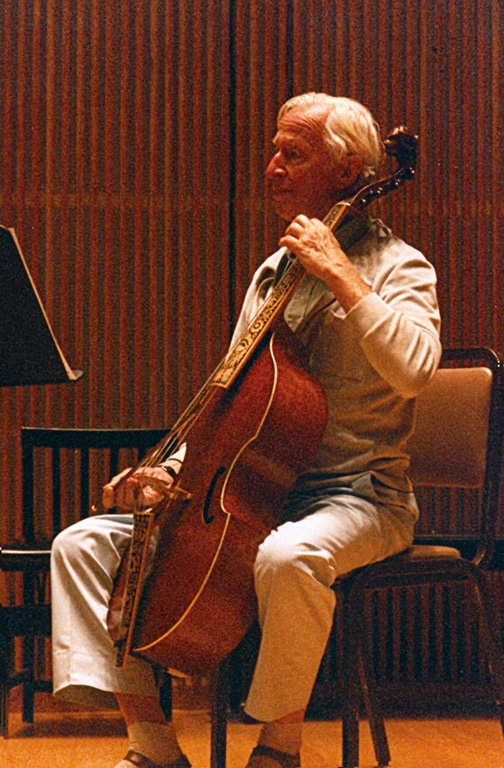
August Wenzinger came to direct the Oberlin Baroque Performance Institute in 1972, and after the first summer he never bothered to bring his Stainer. We always had something he was happy with! We made a number of LPs with him at BPI using our instruments.
August Wenzinger playing the c1685 Tielke at the Baroque Performance Institute at Oberlin, c1980.
The Oberlin Consort of Viols evolved as a New Year’s holiday get-together of our consort friends playing our viols and we made recordings of consort music by Purcell and Lawes. Several of these records were remastered for CDs but a few are still only on vinyl LPs and deserve to be heard more readily.
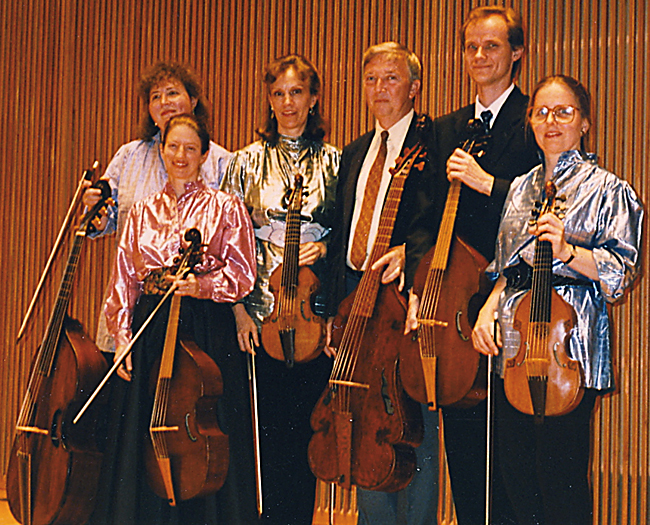
The Oberlin Consort of Viols in the mid-1980s. Left to right: Margriet Tindemans, Alice Robbins, Catharina Meints, James Caldwell, Sergei Istomin, Mary Anne Ballard.
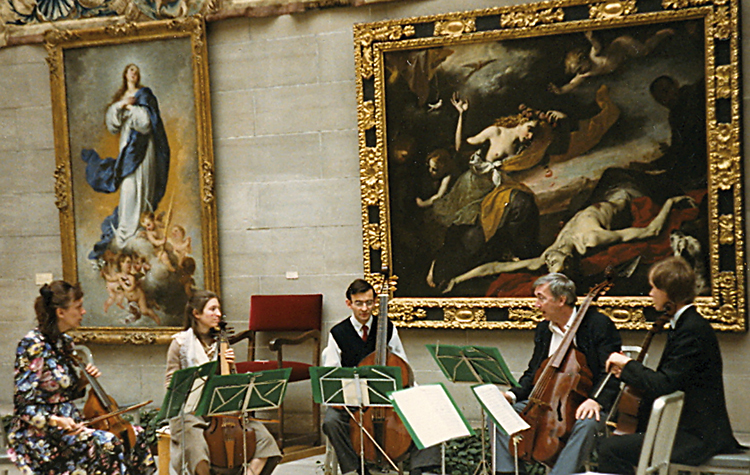
The Oberlin Consort of Viols in rehearsal at the Cleveland Museum of Art in the late 1980s. Left to right: Catharina Meints, Alice Robbins, José Vásquez, James Caldwell, Sergei Istomin.
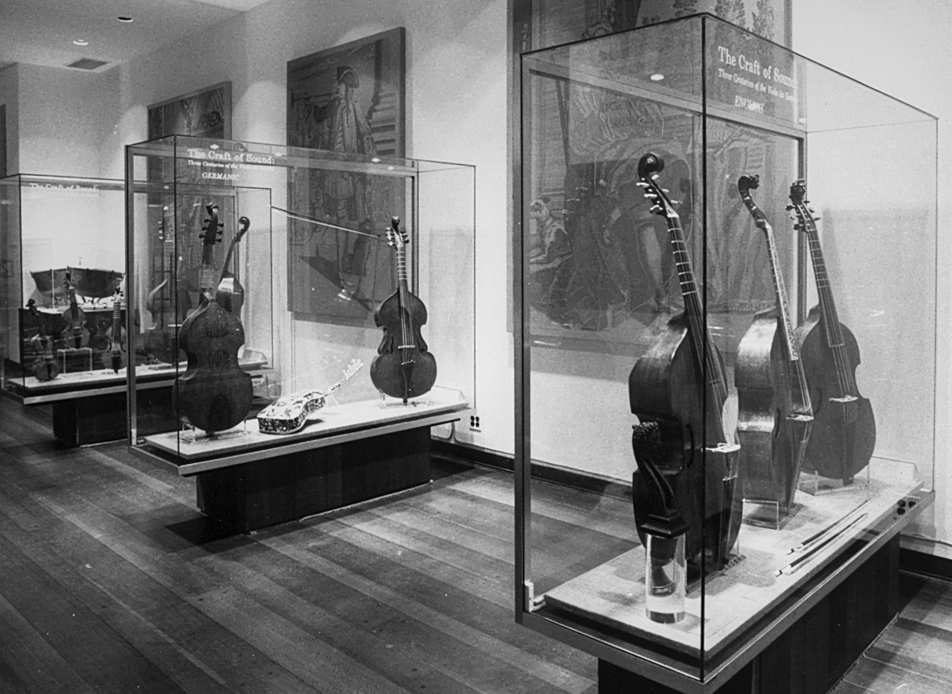
Exhibit at the Smithsonian in honor of August Wenzinger’s 75th birthday in 1980. Instruments from both our collection and the Smithsonian’s were displayed.
A major event in the history of the collection was an exhibition in 1980 at the Smithsonian Museum of American History (which houses and displays the fine collection of European as well as American instruments that is owned by the Smithsonian). The celebration was in honor of August Wenzinger’s seventy-fifth birthday and we were asked not only to come to Washington DC to join him for a concert, but also lend a number of our viols for several weeks for an exhibition in his honor. It was a beautiful display, with nine of our instruments next to the Smithsonian collection plus several bows. We were pleased that the viols could be seen by the many visitors who go through that museum. I wrote the brief pamphlet that accompanied the exhibition–my first foray into the catalogue world. We also received a set of museum-quality black-and-white photographs of the viols that served as models for this collection of color photographs.
When Jim was interviewed for the position of oboe teacher at Oberlin College Conservatory of Music in 1971 (he was brought in as a full professor), Dean Emil Danenberg asked him specifically about the collection and was very impressed by the idea of an oboist having such an interest in stringed instruments. This conversation was an important part of Jim’s decision to take the job, and Danenberg was a strong supporter of his interest in early music. The Dean was the necessary force to be able to start the Baroque Performance Institute in 1972.
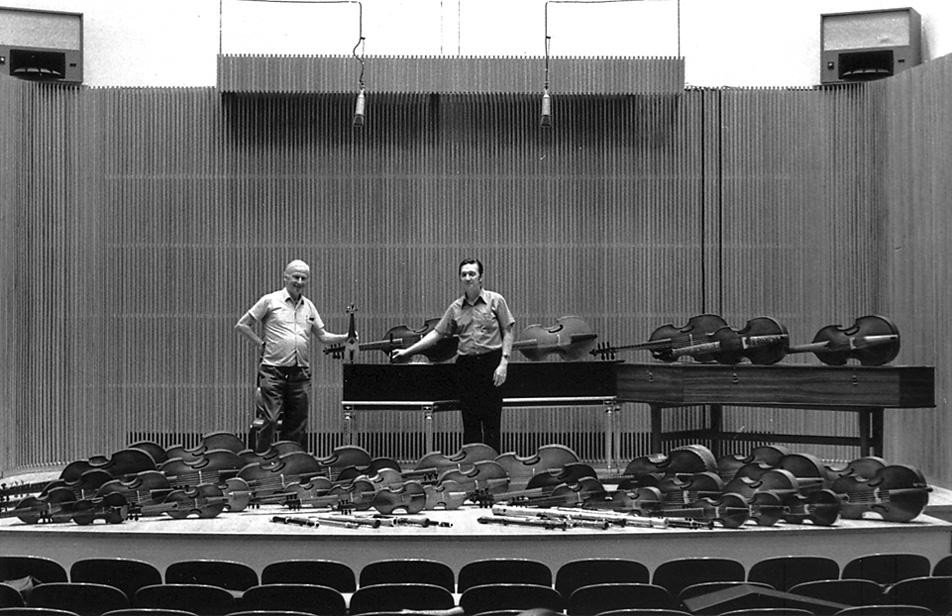
The first year of the Baroque Performance Institute in 1972. August Wenzinger and Jim are beaming over the largest group of gambas assembled in one place in the USA at that time.
That Institute continues to be the premiere summer program for intensive study of baroque performance, and the list of its alumni fills the rosters of many early music ensembles.
In the mid-1970s Jim was granted a special year-long Research Status sabbatical from Oberlin. His project was to visit a number of museums and private instrument collections in Europe for the purpose of studying the national styles of both viols and baroque oboes. At this time harpsichord builders were becoming more sophisticated in this field, but other early-instrument makers were behind in the recognition that, for instance, English viols and French viols were very different. He spent a lot of time on that trip visiting restorers and dealers and much of the restoration of our viols resulted from that trip. We set up relationships particularly with Paul Reichlin, Michael Heale and Tony Bingham. Each instrument required a trip to deliver, a trip to pick up, and much correspondence across the ocean in between. On my own trips to Europe with the Cleveland Orchestra I would also go to museums, see the dealers and transport instruments, but it was almost entirely Jim who had the knowledge and made the decisions. One of my deepest regrets in writing this history and catalogue is that so much knowledge died in 2006 with Jim. He had that unusual gift of visual memory that allowed him to see instruments years apart and remember their similarities and characteristics.
» Swipe for more pictures.
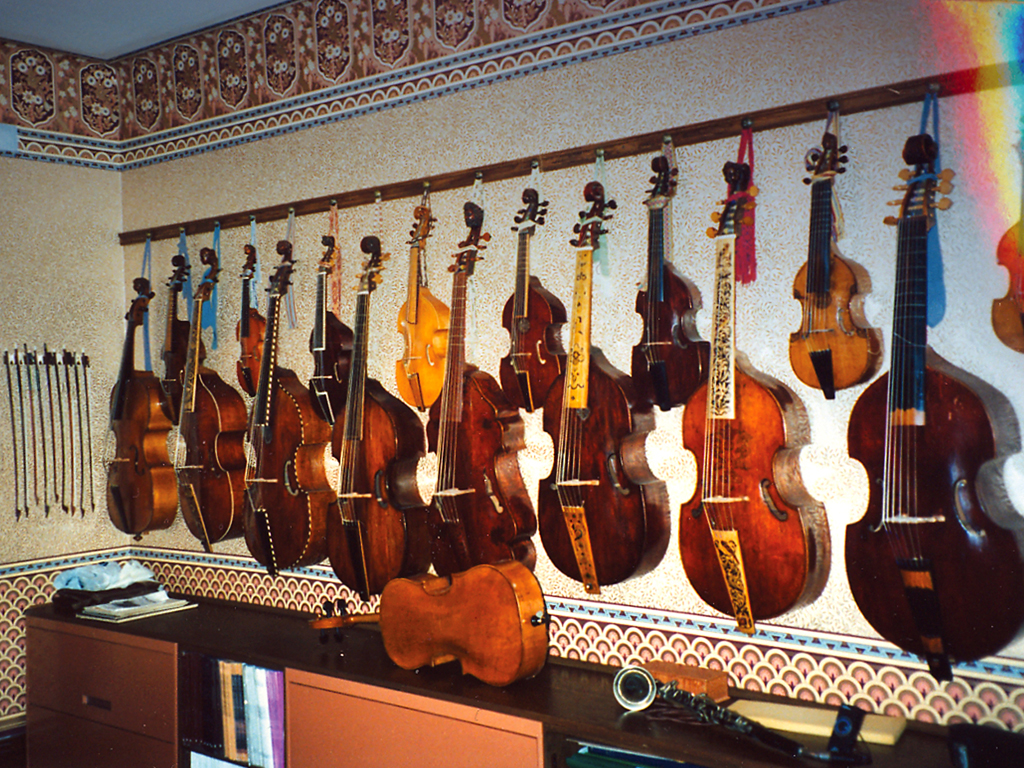
The wall of gambas at our 1893 Victorian home, where we lived for 25 years while we were building the collection.
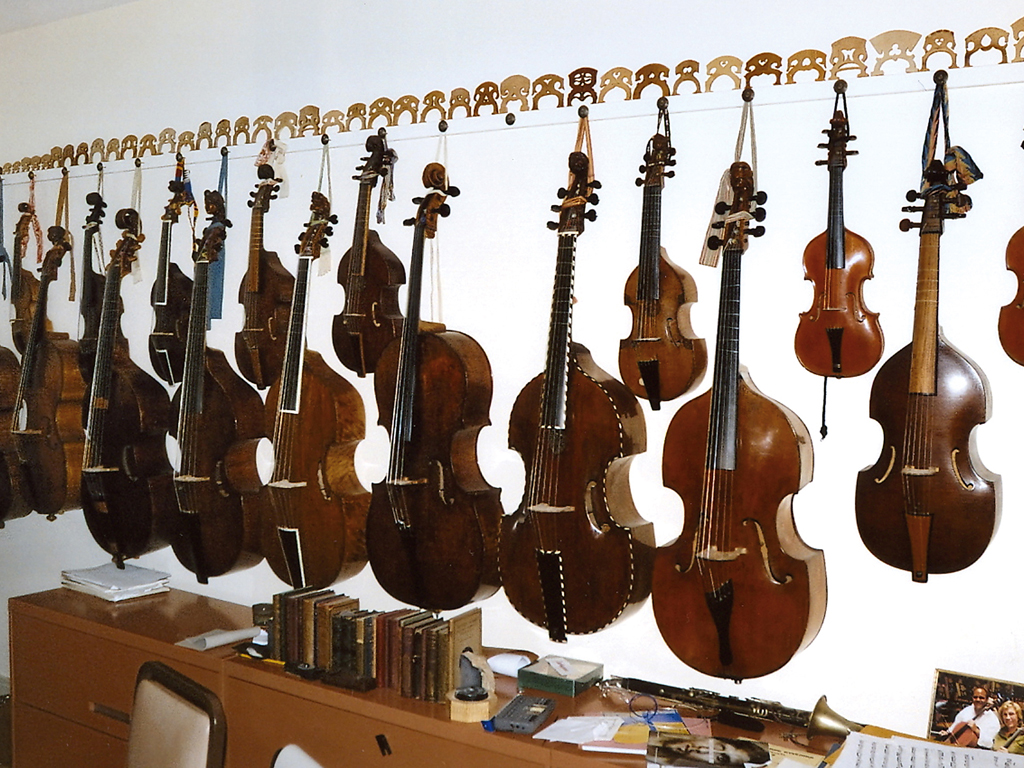
The wall of gambas in our house built in 2004. We measured how much wall space we needed to hang all the instruments and built the display areas that large. We had to stop adding to the collection! Notice the collection of bridges from various restorations. In the lower right hand corner is a picture of my stand partner in the Cleveland Orchestra, Ralph Curry, who bought my Panormo cello when we bought the Amati.
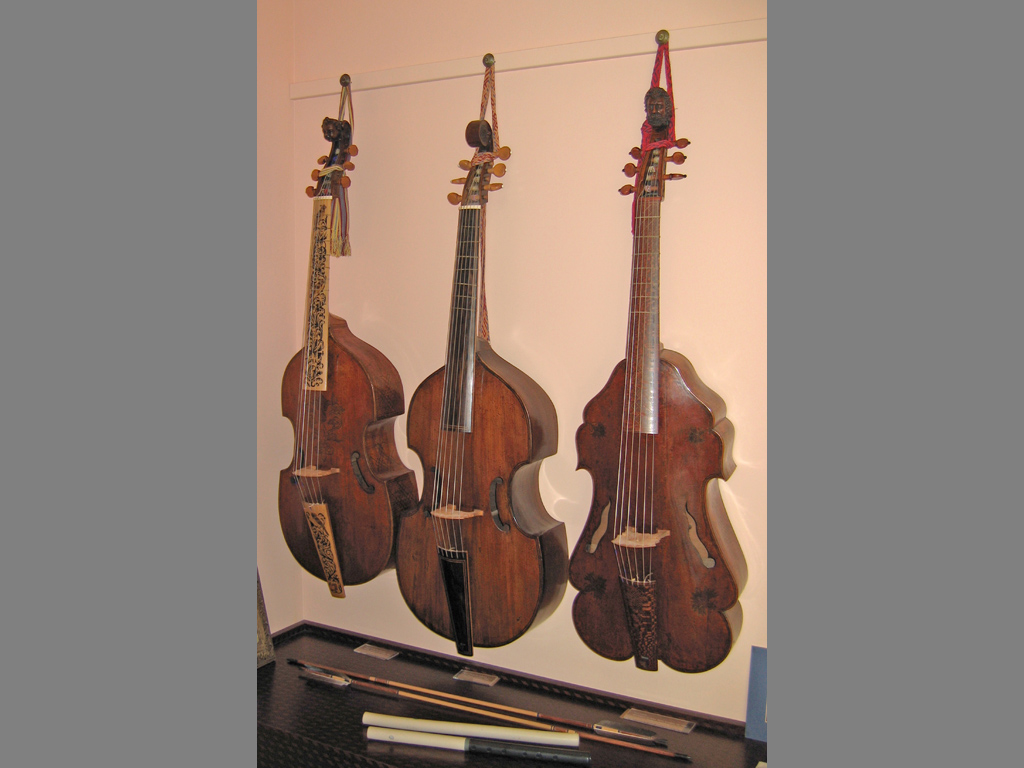
“The English Corner. ” Left to right: Barak Norman, 1584 Rose, c1600 Rose.
Jim’s enjoyment of playing the viol made him reluctant to make the logical foray into the baroque oboe. But finally the other faculty at Oberlin put enough pressure on him that he submitted. Of course, once he started a challenge, he would not be stopped until he had conquered it, and his baroque oboe playing was some of the best ever. These two movements of a Telemann sonata in a minor were recorded for Gasparo Records, a recording company run by cellist Roy Christensen for which we made most of our recordings. I am playing the English baroque cello and Lisa Crawford is playing harpsichord.
/ 04:06
Jim’s enjoyment of playing the viol made him reluctant to make the logical foray into the baroque oboe. But finally the other faculty at Oberlin put enough pressure on him that he submitted. Of course, once he started a challenge, he would not be stopped until he had conquered it, and his baroque oboe playing was some of the best ever. These two movements of a Telemann sonata in a minor were recorded for Gasparo Records, a recording company run by cellist Roy Christensen for which we made most of our recordings. I am playing the English baroque cello and Lisa Crawford is playing harpsichord.
/In the 1980s and 90s Jim began to pursue other interests. He was now performing regularly on baroque oboe, and at one point we had 600 bonsai trees in our back yard! We now had a son, Jonathan, born in 1981, and family life became important. I continued to play the viols actively, but Jim’s playing gradually became limited to the Oberlin Consort of Viols at the holidays. We still had two important viols to be restored, and eventually we found a wonderful restorer for them, so by 2005 all of the Caldwell Collection of Viols was playable. We have continued to show them to all who are interested, encourage their study, and I often have consort evenings with my students. Making the recording that accompanies this catalogue has been a gratifying project as I have fallen in love with each instrument again, and in doing so, I have remembered Jim Caldwell and the gifts he brought to my life.
Catharina Meints was born in 1945 in Dayton, Ohio, and grew up in Hinsdale, Illinois. While attending the Eastman School of Music, she played with the Rochester Philharmonic and Chicago’s Grant Park Symphony. After graduation in 1966 she joined the Chamber Symphony of Philadelphia as assistant principal cello, then went with her new husband, James Caldwell, to the National Symphony. In 1971 she became a member of the Cleveland Orchestra where she remained until retirement in 2006. During those years she began to teach at the Oberlin College Conservatory of Music, playing with the Oberlin Baroque Ensemble and Oberlin Consort of Viols and teaching at the Baroque Performance Institute. She made a number of recordings of chamber music playing viola da gamba, baroque cello, and modern cello. After her retirement from the Cleveland Orchestra she expanded her teaching at Oberlin, becoming Associate Professor of Viola da Gamba, Baroque Cello, and Cello. She and her husband have a son, Jonathan, born in 1981.
Born in 1938 in Gladewater, Texas, James Boone Caldwell graduated from the Curtis Institute of Music in 1961 and was a member of the Soni Ventorum Wind Quintet until 1965, when he was appointed principal oboe of the National Symphony in Washington, D.C. From 1966 to 1968 he was principal oboe of the Chamber Symphony of Philadelphia, before returning to the National Symphony for three more seasons. In 1971 he took the position of Professor of Oboe at the Oberlin College Conservatory of Music, where he was a member of the Oberlin Wind Quintet and founded the Baroque Performance Institute. He played both viola da gamba and baroque oboe with the Oberlin Baroque Ensemble, the Oberlin Consort of Viols, and the Smithsonian Chamber Players, making a number of recordings with each of those groups over the years. A final CD, “Building Castles in the Sky,” is an anthology of his career, including examples of his art work as well as previous recordings and live performances. It was released by Boston Records in the month of his death, February 2006.